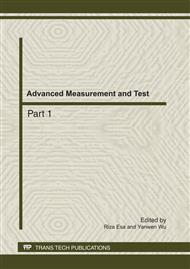[1]
I. Gohberg et al. Matrix Polynomials. New York: Academic Press(1982).
Google Scholar
[2]
G. M. L. GLADWELL. Inverse Problems Vibration. Boston, MA: Martinus Nijhoff Publishers(1986).
Google Scholar
[3]
P. LANCASTER and J. MAROULAS. Journal of Mathematical Analysis and Application, 123, 238-261. Inverse eigenvalue problems for damped vibrating systems(1987).
DOI: 10.1016/0022-247x(87)90306-4
Google Scholar
[4]
L. STAREK, D. J. INMAN and A. KRESS. ASME Journal of Vibration and Acoustics 114, 564-568. A symmetric inverse vibration problem(1992).
DOI: 10.1115/1.2930299
Google Scholar
[5]
L. STAREK and D. J. INMAN. ASME Journal of Applied Mechanics 64, 601-605. A symmetric inverse vibration problem for non-proportional underdamped system(1997).
DOI: 10.1115/1.2788935
Google Scholar
[6]
L. STAREK and D. J. INMAN. ASME Journal of Applied Mechanics 58, 1101-1104. On the inverse vibration problem with rigid body modes(1991).
DOI: 10.1115/1.2897693
Google Scholar
[7]
L. STAREK and D. J. INMAN. Journal of Sound and Vibration 181, 893-903. A symmetric inverse vibration problem with over-damped modes(1995).
DOI: 10.1006/jsvi.1995.0176
Google Scholar
[8]
G. R. Reklaitis, A. Ravindran and K. M. Ragsdell. Engineering Optimization Methods and Applications. John Wiley and Sons(1983).
DOI: 10.1080/03052158508902497
Google Scholar
[9]
Y. Yin and K. V. Horoshenkov. Attenuation of the higher-order cross-sectional modes in a duct with a thin porous layer. J. Acoust. Soc. Am., Vol. 117(2), 528-535 (2005).
DOI: 10.1121/1.1823211
Google Scholar
[10]
K. V. Horoshenkov and M. J. Swift. The acoustic properties of granular materials with pore size distribution close to log-normal. J. Acoust. Soc. Am., Vol. 110 (5), 2371-2378 (2001).
DOI: 10.1121/1.4809157
Google Scholar
[11]
Zhongxiang Chen, Chaoyuan Yue. Research on the Data Acquisition in the Schedule Risk Analysis. Advances in Systems Science and Applications. Vol. 4, No. 2 287-292(2004).
Google Scholar
[12]
Man Liu. Note on Algebras Endowed with Two Lattice Structures. Advances in Systems Science and Applications. Vol. 4, No. 2 189-192(2004).
Google Scholar
[13]
Haijun Wang, Dexin Cao, Jing Sun. Minimax Method for a Class Nonsmooth Global Optimization Problem. Advances in Systems Science and Applications. Vol. 5, No. 2 271-276 (2005).
Google Scholar


